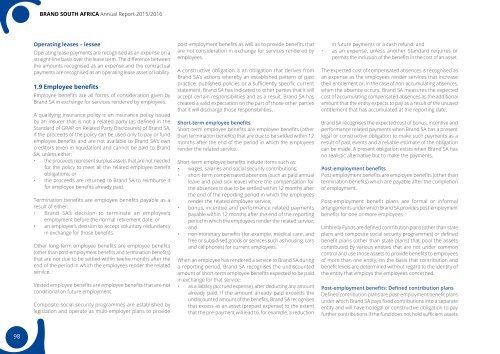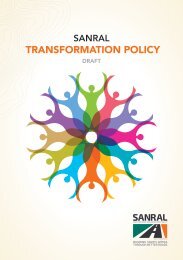Brand-South Africa - Annual report 2015 - 2016
During the past financial year, aligned with its mandate to build pride and patriotism in the Nation Brand, Brand South Africa has worked on initiatives to encourage active citizenship in partnership with its stakeholders in government, business, civil society and identified influential forums to increase the participation of all people, particularly our young people, in building a strong, cohesive Nation Brand. These activities, together with engagements at provincial level on Nation Brand alignment, contribute to social cohesion and a positive Nation Brand. Brand South Africa’s activities took place under the leadership of its new CEO, Amb. Kingsley Makhubela, PhD, who joined the organisation during the year.
During the past financial year, aligned with its mandate to build pride and patriotism in the Nation Brand, Brand South Africa has worked on initiatives to encourage active citizenship in partnership with its stakeholders in government, business, civil society and identified influential forums to increase the participation of all people, particularly our young people, in building a strong, cohesive Nation Brand. These activities, together with engagements at provincial level on Nation Brand alignment, contribute to social cohesion and a positive Nation Brand.
Brand South Africa’s activities took place under the leadership of its new CEO, Amb. Kingsley Makhubela, PhD, who joined the organisation during the year.
Create successful ePaper yourself
Turn your PDF publications into a flip-book with our unique Google optimized e-Paper software.
and south africa <strong>Annual</strong> Report <strong>2015</strong>/<strong>2016</strong><br />
Operating leases – lessee<br />
Operating lease payments are recognised as an expense on a<br />
straight-line basis over the lease term. The difference between<br />
the amounts recognised as an expense and the contractual<br />
payments are recognised as an operating lease asset or liability.<br />
1.9 Employee benefits<br />
Employee benefits are all forms of consideration given by<br />
<strong>Brand</strong> SA in exchange for services rendered by employees.<br />
A qualifying insurance policy is an insurance policy issued<br />
by an insurer that is not a related party (as defined in the<br />
Standard of GRAP on Related Party Disclosures) of <strong>Brand</strong> SA,<br />
if the proceeds of the policy can be used only to pay or fund<br />
employee benefits and are not available to <strong>Brand</strong> SA’s own<br />
creditors (even in liquidation) and cannot be paid to <strong>Brand</strong><br />
SA, unless either:<br />
• the proceeds represent surplus assets that are not needed<br />
for the policy to meet all the related employee benefit<br />
obligations; or<br />
• the proceeds are returned to <strong>Brand</strong> SA to reimburse it<br />
for employee benefits already paid.<br />
Termination benefits are employee benefits payable as a<br />
result of either:<br />
• <strong>Brand</strong> SA’s decision to terminate an employee’s<br />
employment before the normal retirement date; or<br />
• an employee’s decision to accept voluntary redundancy<br />
in exchange for those benefits.<br />
Other long-term employee benefits are employee benefits<br />
(other than post-employment benefits and termination benefits)<br />
that are not due to be settled within twelve months after the<br />
end of the period in which the employees render the related<br />
service.<br />
Vested employee benefits are employee benefits that are not<br />
conditional on future employment.<br />
Composite social security programmes are established by<br />
legislation and operate as multi-employer plans to provide<br />
post-employment benefits as well as to provide benefits that<br />
are not consideration in exchange for services rendered by<br />
employees.<br />
A constructive obligation is an obligation that derives from<br />
<strong>Brand</strong> SA’s actions whereby an established pattern of past<br />
practice, published policies or a sufficiently specific current<br />
statement, <strong>Brand</strong> SA has indicated to other parties that it will<br />
accept certain responsibilities and as a result, <strong>Brand</strong> SA has<br />
created a valid expectation on the part of those other parties<br />
that it will discharge those responsibilities.<br />
Short-term employee benefits<br />
Short-term employee benefits are employee benefits (other<br />
than termination benefits) that are due to be settled within 12<br />
months after the end of the period in which the employees<br />
render the related service.<br />
Short-term employee benefits include items such as:<br />
• wages, salaries and social security contributions;<br />
• short-term compensated absences (such as paid annual<br />
leave and paid sick leave) where the compensation for<br />
the absences is due to be settled within 12 months after<br />
the end of the <strong>report</strong>ing period in which the employees<br />
render the related employee service;<br />
• bonus, incentive and performance related payments<br />
payable within 12 months after the end of the <strong>report</strong>ing<br />
period in which the employees render the related service;<br />
and<br />
• non-monetary benefits (for example, medical care, and<br />
free or subsidised goods or services such as housing, cars<br />
and cellphones) for current employees.<br />
When an employee has rendered a service to <strong>Brand</strong> SA during<br />
a <strong>report</strong>ing period, <strong>Brand</strong> SA recognises the undiscounted<br />
amount of short-term employee benefits expected to be paid<br />
in exchange for that service:<br />
• as a liability (accrued expense), after deducting any amount<br />
already paid. If the amount already paid exceeds the<br />
undiscounted amount of the benefits, <strong>Brand</strong> SA recognises<br />
that excess as an asset (prepaid expense) to the extent<br />
that the pre-payment will lead to, for example, a reduction<br />
in future payments or a cash refund; and<br />
• as an expense, unless another Standard requires or<br />
permits the inclusion of the benefits in the cost of an asset.<br />
The expected cost of compensated absences is recognised as<br />
an expense as the employees render services that increase<br />
their entitlement or, in the case of non-accumulating absences,<br />
when the absence occurs. <strong>Brand</strong> SA measures the expected<br />
cost of accumulating compensated absences as the additional<br />
amount that the entity expects to pay as a result of the unused<br />
entitlement that has accumulated at the <strong>report</strong>ing date.<br />
<strong>Brand</strong> SA recognises the expected cost of bonus, incentive and<br />
performance related payments when <strong>Brand</strong> SA has a present<br />
legal or constructive obligation to make such payments as a<br />
result of past events and a reliable estimate of the obligation<br />
can be made. A present obligation exists when <strong>Brand</strong> SA has<br />
no realistic alternative but to make the payments.<br />
Post-employment benefits<br />
Post-employment benefits are employee benefits (other than<br />
termination benefits) which are payable after the completion<br />
of employment.<br />
Post-employment benefit plans are formal or informal<br />
arrangements under which <strong>Brand</strong> SA provides post-employment<br />
benefits for one or more employees.<br />
Umbrella Funds are defined contribution plans (other than state<br />
plans and composite social security programmes) or defined<br />
benefit plans (other than state plans) that pool the assets<br />
contributed by various entities that are not under common<br />
control and use those assets to provide benefits to employees<br />
of more than one entity, on the basis that contribution and<br />
benefit levels are determined without regard to the identity of<br />
the entity that employs the employees concerned.<br />
Post-employment benefits: Defined contribution plans<br />
Defined contribution plans are post-employment benefit plans<br />
under which <strong>Brand</strong> SA pays fixed contributions into a separate<br />
entity and will have no legal or constructive obligation to pay<br />
further contributions if the fund does not hold sufficient assets<br />
98











